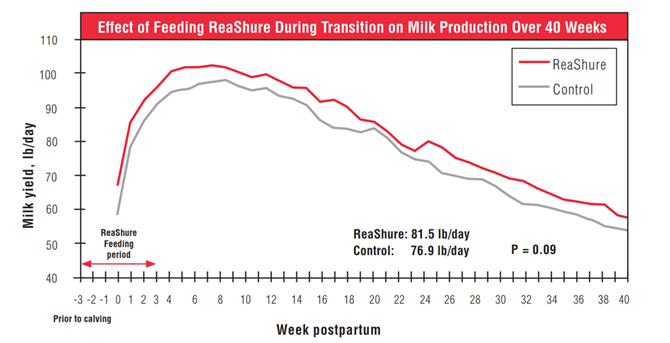Myth #5: If You Are Feeding Goldilocks Diets, You do Not Have to Feed Rument-Protected Choline
Feeding Goldilocks diets are viewed as favorable for transition cow health due to their ability to moderate fat mobilization. Consequently, the recommendation to feed RPC to lower liver fat and improve animal health is often rejected by nutrition advisors when Goldilocks diets are fed.
BACKGROUND
BACKGROUND In a previous mythbusting article, we discussed different strategies for managing fat mobilization during the transition period. The traditional approach has been to try and reduce fat mobilization to prevent potential negative consequences associated with elevated blood non-esterified fatty acids (NEFA) and beta-hydroxybutyrate (BHBA). Controlled energy diets, also referred to as Goldilocks diets, have proven to be very successful in moderating fat mobilization as indicated by lower blood NEFA and BHBA and lower fat in the liver (Janovick et al., 2011; Richards, 2011; Zenobi et al., 2018). It is thought that these diets may enhance insulin sensitivity of fat tissues. An alternative approach has been to let fat mobilization occur unchecked, but help the liver process the NEFA and enhance their export as a constituent of very low-density lipoprotein triglyceride (VLDL). VLDL triglyceride can then be utilized by the mammary gland for milk synthesis. Feeding rumen-protected choline (RPC) is the only known tool that can help the liver deal with the large influx of NEFA during the transition period and result in lower liver fat accumulation and enhanced lactation performance (Grummer, 2012). Logical questions are: do you need to use only one approach? Is one approach superior? Are the results from each approach additive or redundant?
BUSTING THE MYTH: COWS RESPOND TO RUMEN-PROTECTED CHOLINE REGARDLESS OF DIET FED
The University of Florida recently conducted an experiment to determine if RPC is more helpful to multiparous cows when they over consume energy during the dry period compared to when they are fed to meet energy requirements (i.e., a Goldilocks diet; Zenobi et al., 2018). Cows were fed four dietary treatments in a 2×2 factorial arrangement. A controlled energy diet (to meet energy requirements) was fed to half the cows for the entire dry period (average 48 days). The other half of the dry cows received a diet that provided approximately 140% of energy requirements. After calving, all cows were fed a diet with the same energy density. Half the cows fed each energy level were fed a diet without supplemental RPC; the other half received 15 grams/day of choline chloride in a rumen-protected from three weeks precalving until three weeks postcalving. Surprisingly, there were virtually no interactions for the parameters measured in this study. In other words, the response to RPC was the same regardless of what diet was fed during the dry period. The milk response was 4.8 lbs/day for the 15 week trial. The researchers continued to monitor milk production after the trial was completed and the response persisted through 40 weeks postpartum (Figure 1). Interestingly, the milk response was almost identical to the average milk response in a 13 trial meta-analysis that was discussed in a previous mythbusting article (4.9 lbs/day; Grummer, 2012).
*FIGURE 1
Changes in NEFA uptake by the liver during the transition period. (Figure by Thomas Overton, Cornell University; created from data of Reynolds et al., 2004.)

TAKE HOME MESSAGE
The Florida trial indicated that the response to RPC was independent of diet being fed during the dry period. Therefore, nutrition advisors can recommend feeding RPC to transition cows even if they are being fed the Goldilocks diet during the dry period. This agrees with a conclusion forwarded in a previous mythbuster article: all cows can benefit from supplementation with RPC because all cows have a calf. Calving and initiation of lactation induces biological changes which render the transition cow deficient in choline.
Sources
GRUMMER, R. R. 2012.
Choline: A limiting nutrient for transition dairy cows. Proc. Cornell Nutr. Conf.
JANOVICK, N. A., Y. R. BOLSCLAIR, AND J. K. DRACKLEY.
2011. Prepartum dietary energy intake affects metabolism and health during the periparturient period in primiparous and multiparous Holstein cows. J. Dairy Sci. 94:1385-1400.
RICHARDS, B. F. 2011.
Strategies to Decrease Fatty Liver in Dairy Cows. PhD Thesis. University of Illinois, Urbana-Champaign.
ZENOBI, M. G., R. GARDINAL, J. E. ZUNIGA, A. L. G.
Dias, C. D. Nelson, J. P. Driver, B. A. Barton, J. E. P. Santos, and C. R. Staples. 2018. Effects of supplementation with ruminally protected choline on performance of multiparous Holstein cows did not depend upon prepartum caloric intake. J. Dairy Sci. 101:1088-1327.
